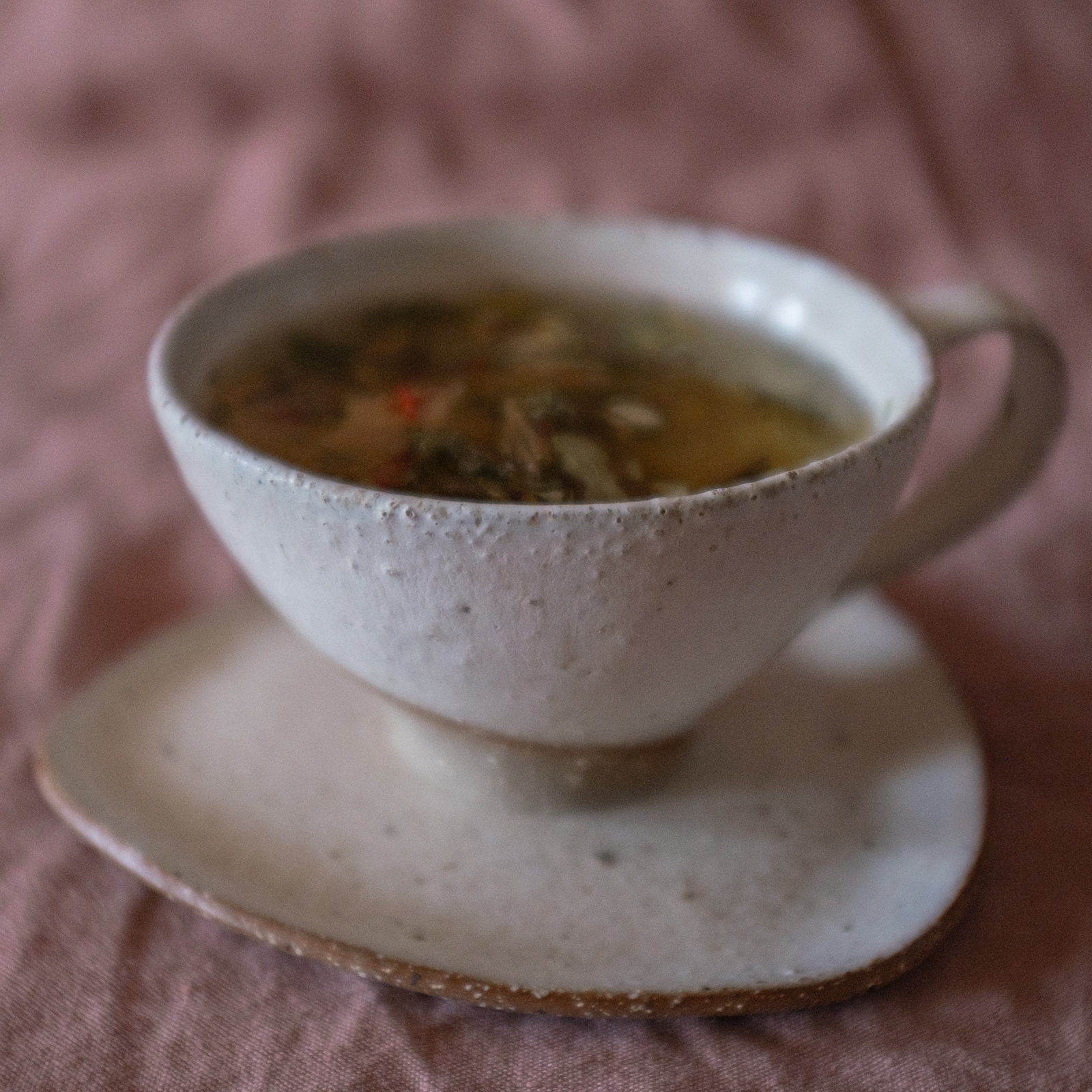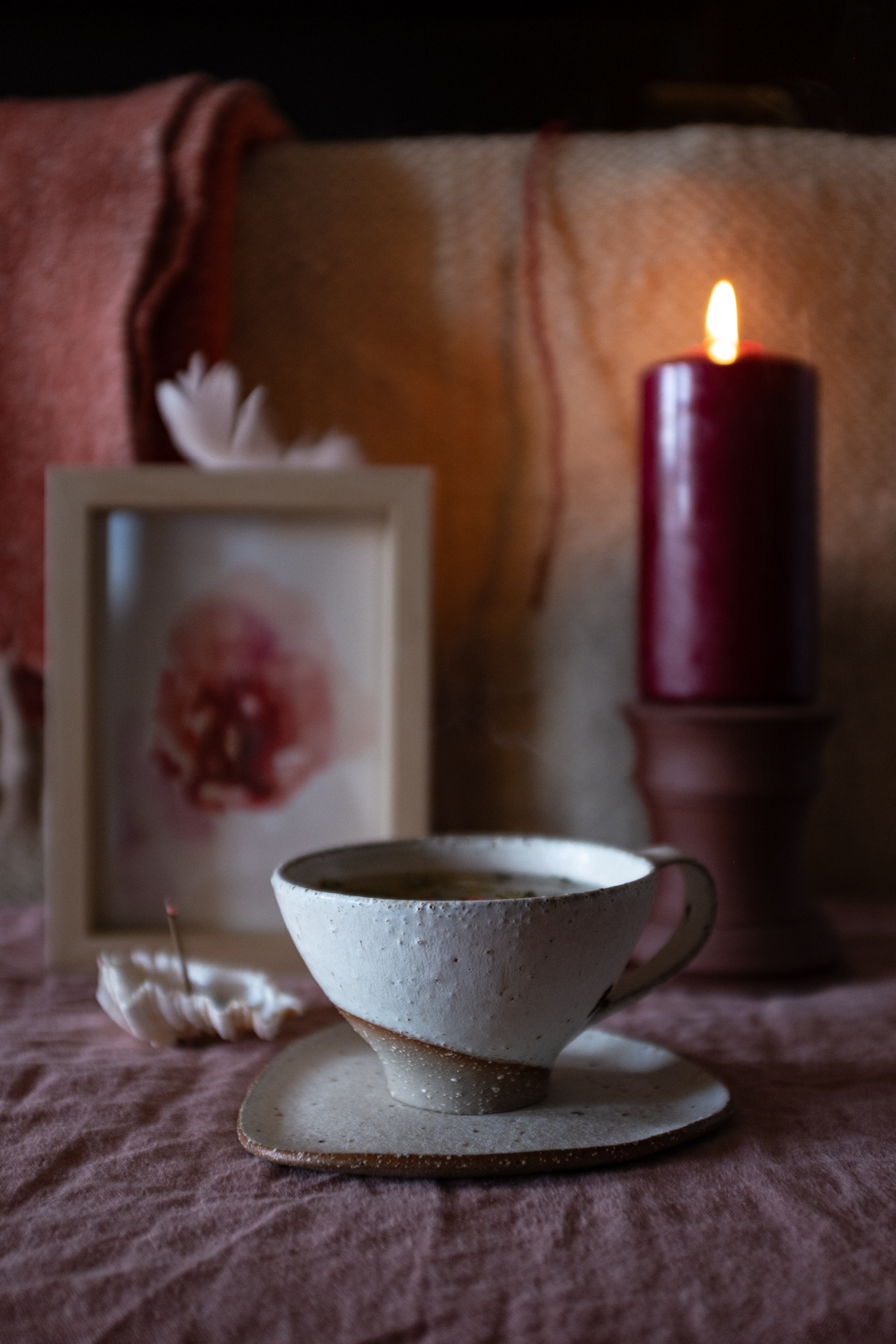Recycled clay, psilocybin and Magdalena tea cup
I would like to share with you the insight into my subconsciousness I received while doing a psychedelic mushroom ritual at my grandfathers meadow. You see I am always curious why I love doing certain things while others I resent and avoid. My intention with the mushrooms this time was to get a clearer insight into my thinking processes. So I observed my thoughts very carefully and made notes in between into my notebook. Among many other things that I addressed, this one I would like to share and it is about things that people discard. I look at psilocybin mushrooms as gates into subconsciousness.
We were in the meadow that used to have a potato field and now belongs to my uncle and we took mushrooms. No one is farming there any more. I was observing and walking around and one thing that attracted me was a patch of land that was overgrown with shrubs. There were small young bushes and trees that started growing. They started growing because nobody cut the grass there because it was not possible, because there were rocks lying around, different in sizes. It looked like people were clearing the field for farming and while doing so they removed the rocks that were laying around the whole area and discarded it at the small area at the side of the field. 2 large linden trees also started to grow there and since they were huge, they must have been at least 100 years old, so even older than my grandfather. One was damaged and it fell down, and it was cut into smaller pieces, waiting to be picked for fire food. I went there and sat on one of the wood blocks. As I sat there I observed what was going on here and the question that arose in my mind was: why was I attracted there, to this part of the land where people were placing things they didn’t want: rocks from the whole plot of land, belonging to my family. I started laughing out loud because in my mind my grandmother was there and telling me: “You Anja, you get to take care of all the things in your family that all the rest don’t want to deal with, for all the things people in this family sweep under the rug and hide it. Including and especially feelings.” Ok, mama Stanka, I understand. So that was the message received during that time, I am the one to take care of things people in our family discard.
Good thing about things people don’t want is also the silence and the peace that comes with it. I will explain on one example: when I was a kid, in kindergarten, we were offered toys for example. Most of children jumped into getting the coolest one, the most colourful one or the biggest one. I was waiting and looking for the most uninteresting one – the one that I could get in my own time in peace and quiet. That points out to my other features, but let’s focus one one that is interesting here: I would then challenge myself how to get the most out of this seemingly boring toy or how would I create environment or something creative with it that I could prove to myself and others I can make beauty out of anything. This also points out to few other challenges from my childhood, but keeping focus here, the point here is this: I can make beauty out of anything. I have the ability of transforming.
Even my grandfather used to collect things that people threw away or didn’t want anymore. Partly because he couldn’t afford everything: he came from a family of wealth that lost everything, and partly because he still could recognise features of quality and beauty in things. For example, he collected old oak wood, furniture and things made of metal. He would then fix it, clean it, paint it and create a new pieces – like recycle them. He was the recycle king. I also noticed that my brother, who is a carpenter, doesn’t use a lot of newly bought wood. He just brings home small cutting from their factory and makes small things from it.
Affinity for scraps comes from many sides and corners. And what I love now in my own studio is very much using leftover clay. Using clays that is left after finishing a project, after it is left after students finish their work, pieces of dry or moist clay left from past work that are left here and there and so on. I collect all those pieces in one big bucket through months and after the bucket is full, I cover leftover clay with water and leave it. For days or months too, until I decide to recycle it completely.
After it has been thoroughly soaked in water and so made soft, the clay can be mixed either with hands (that is more in the case if all the leftover clay was first super dry, then soaked, then it breaks down completely on its own) or with a electric mixer (more convenient if the clay was still plastic before soaking in water).
Then comes my favourite part: pouring and pushing the sticky but still considered liquid (best somewhere in between, like it can still be poured, but super thick) clay through sieve. Doing that is optional or not necessary if your clay don’t contain any sands or impurities. Since I use all sorts of groggy clays, sands and unclean local clays I prefer to eliminate all the bigger size particles. Choosing different mesh size of the sieve also gives finer and grainier clays.
Features of single clays are then combined in the mixture of the bucket: not only colour of course, but also plasticity – stickiness, firing temperature and graininess. And I just love mix-it all-together clays! They are smooth, clean again, OCD-satisfied recycled clays that usually fire in taupe sandy shades. Again – depending on the mixture.
One of those clays is also used for Magdalena tea cup into which I also added Straža galaxy sand:


